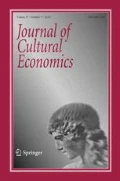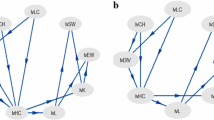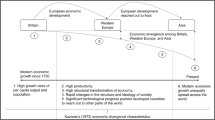Abstract
This paper explores the link between culture and regional development in USA counties by explicitly including an arts variable in an attitudes-driven culture-based development (CBD) production function. The main aims of the research are (1) to revisit the standard CBD model in order to examine whether its findings from the European Union context hold also for the United States and (2) to expand the CBD standard inquiry of local development beyond economic welfare. In relation to the latter, we address in particular (1) the effect of local cultural industries on migration (as a continuation of Florida’s hypothesis) and (2) the effect of culture on social well-being (alternatively measured by means of level of happiness and level of crime in terms of property theft). Our paper is, therefore, a novel contribution, providing a better understanding of the link between arts, culture and regional development and also facilitating an innovative evaluation of cultural impact relevant in the developmental debate in an extended socio-economic sense. The data used in this inquiry comprise a composite dataset, a cross section for the year 2000 at the county level combining census data with the cultural vitality index from the Western States Arts Federation and happiness variables from the general social survey panel for 2006. A three-stage least squares exploration of recursive types of a standard CBD and an extended CBD model leads to three main results: (1) the existence of a CBD cultural effect on local development is confirmed for the USA; (2) endogenous cultural industries have an effect on the mobility of human capital, and (3) the impact of cultural effects seems to be more significant when a negative Myrdalian vicious cycle is assumed.
Similar content being viewed by others
Notes
It should be noted the component-based SEM (PLS-PM) used in this paper has certain empirical advantages over the covariance-based SEM used by Florida and Mellander (2010) in exploring new models.
We refer here to the literature on cultural transmission as an interaction on individual level—as defined and described by Bisisn and Verdier (2005). Like with Bourdieu’s notion of cultural capital, CBD looks on cultural transmission an aggregate level. Next, CBD also extends beyond the interesting but monodimensional variable approach of Klasing (2008) which deals with transmission mechanism and culture on local level, yet focusing only on the culture as risk preference facet of cultural capital.
References
Aleksynska, M., & Chiswick, B. R. (2011). Religiosity and migration: Travel into one’s self versus travel across cultures. IZA Discussion Papers 5724, Institute for the Study of Labor (IZA).
Alesina, A., & La Ferrera, E. (2003). Ethnic diversity and economic performance. Mimeo: Harvard University, Department of Economics.
Axelrod, R. (1997). The dissemination of culture: A model with local convergence and global polarization. The Journal of Conflict Resolution, 41(2), 203–226.
Barro, R., & McCleary, R. (2003). Religion and economic growth across countries. American Sociological Review, 68(5), 760–781.
Barro, R., & McCleary, R. (2005). Which countries have state religions? Quarterly Journal of Economics, 120(4), 1331–1370.
Baumeister, R., Bratslavsky, E., & Western, C. (2001). Bad is stronger than good. Review of General Psychology, 5(4), 323–337.
Becker, G. (1968). Crime and punishment. Journal of Political Economy, 76(2), 196–217.
Becker, G. S., Philipson, T. J., & Soares, R. R. (2005). The quantity and quality of life and the evolution of world inequality. American Economic Review, American Economic Association, 95(1), 277–291.
Bednar, J., Bramson, A., Rooy, A., & Page, S. (2010). Emergent cultural signatures and persistent diversity: A model of conformity and consistency. Rationality and Society, 22, 407–444.
Bednar, J., & Page, S. E. (2007). Can game(s) theory explain culture? The emergence of cultural behavior within multiple games. Rationality and Society, 19(1), 65–97.
Bisin, A., & Verdier, T. (2001a). The economics of cultural transmission and the dynamics of preferences. Journal of Economic Theory, 97, 298–319.
Bisin, A., & Verdier, T. (2001b). Agents with imperfect empathy might survive natural selection. Economics Letters, 2, 277–285.
Bisin, A., & Verdier, T. (2010). The economics of cultural transmission and socialization. NBER Working Papers 16512, National Bureau of Economic Research, Inc.
Bisisn, A., & Verdier T. (2005). Cultural transmission, New Palgrave Dictionary of Economics, Second Edition. Palgrave Macmillan, Basingstoke.
Borjas, G. (1999). Heaven’s door. Princeton and Oxford: Princeton University Press.
Borjas, G. (2003). The labour demand curve is downward sloping: Reexamining the Impact of immigration on the labour market. Quarterly Journal of Economics, 118(4), 1335–1374.
Boschma, R., & Fritsch, M. (2007). Creative class and regional growth—empirical evidence from eight European countries. Jena Economic Research Papers 066.
Bourdieu, P. (1973). Cultural reproduction and social reproduction, knowledge, education and social change. In R. Brown (Ed.), Papers in the sociology of education (pp. 71–112). Tavistock, UK: Tavistock Publications.
Bourdieu, P. (1977). Cultural reproduction and social reproduction. In J. Karabel & A. H. Halsey (Eds.), Power and Ideology in Education (pp. 487–511). New York, NY: Oxford University Press.
Bourdieu, P. (1986). The forms of capital. In J. Richardson (Ed.), Handbook of theory and research for the sociology of culture (pp. 241–258). New York, NY: Greenwood.
Bowles, S. (1998). Endogenous preferences: The cultural consequences of markets and other economic institutions. Journal of Economic Literature, 36(1), 75–111.
Card, D. (2001). Immigrant Inflows, native outflows and the local labour market impacts of higher immigration. Journal of Labour Economics, 19, 22–61.
Chiswick, B. R., & Huang, J. (2006). The earnings of American Jewish men: Human capital, denomination and religiosity. IZA Discussion Papers 2301, Institute for the Study of Labor (IZA).
Collier, P. (2001). Implications of ethnic diversity. Economic Policy: A European Forum, 1, 27–55.
Constant, A. F., & Zimmermann, K. F. (2012). Immigrants, ethnic identities and the nation-state. IZA Discussion Papers 7020, Institute for the Study of Labor (IZA).
Dawson, J. (2010). Diversity faultlines, shared objectives, and top management team performance. Human Relations, 64, 307–336.
Di Tella, R., & MacCulloch, R. (2006). Some uses of happiness data in economics. Journal of Economic Perspectives, 20(1), 25–46.
Easterly, W., & Levine, R. (1997). African’s growth tragedy: Policies and ethnic divisions. Quarterly Journal of Economics, 112, 1203–1250.
Florida, R. (2002a). The rise of the creative class: And how it’s transforming work, leisure, community, and everyday life. New York: Basic Books.
Florida, R. (2002b). Bohemia and economic geography. Journal of Economic Geography, 2, 55–71.
Florida, R. (2005). The flight of the creative class: The new global competition for talent. London: Harper Collins.
Florida, R., & Mellander, C. (2010). There goes the metro: How and why artists, bohemians and gays effect housing values. Journal of Economic Geography, 10(2), 167–188.
Florida, R., Mellander, C., & Stolarick, K. (2008a). Inside the black box of regional development: Human capital, the creative class and tolerance. Journal of Economic Geography, 8, 615–649.
Florida, R., Mellander, C., & Stolarick, K. (2008b). Talent, technology and tolerance in Canadian regional development. The Canadian Geographer, 54(3), 277–304.
Fritsch, M., & Stuetzer, M. (2009). The geography of creative people in Germany. International Journal of Foresight and Innovation Policy, 5(1–3), 7–23.
Glaeser, E. (2005). Review of Richard Florida’s the rise of the creative class. Regional Science and Urban Economics, 35, 593–596.
Glaeser, E. L., Kolko, J., & Saiz, A. (2001). Consumer City. Journal of Economic Geography, Oxford University Press, 1(1), 27–50.
Glaeser, E., Scheinkman, J., & Schleifer, A. (1995). Economic growth in a cross section of cities. Journal of Monetary Economics, 36, 117–143.
Guiso, L., Sapienza, P., & Zingales, L. (2006). Does culture affect economic outcomes? Journal of Economic Perspectives, 20(2), 23–48.
Hauser, C. (2013): Regional trust in Europe: Distribution, dynamics and determinants. Presented at ERSA 2013.
Hofstede, G. (2007). Asian management in the 21st century. Asia Pacific Journal of Management, 24(4), 411–420.
Hume, D. ([1757] 1965). Of the standards of taste, in on the standard of taste and other essays. Indianopolis: The Bobbs-Merrill Company.
Jacobs, J. (1969). The economy of cities. New York: Random House.
Janowski, B. (1908 [2013]). On distances as a factor for cultural development, spatial economy classics 1, Spatial Economy Society, Bogucki Wydawnictwo Naukowe, Poznan.
Klasing, M. (2008). Culturally risk averse?—A model of economic growth with endogenous culture. Discussion Paper No. 2008-23.
Kotkin, J. (2004). The capital of what, the New York sun, 19 February, 2004.
Kotkin, J. (2005) Uncool cities. Prospect Magazine, 115. http://www.prospectmagazine.co.uk/article_details.php?id=7072
Kuznets, S. (1955). Economic growth and income inequality. American Economic Review, 45, 1–28.
Lian, B., & Oneal, J. (1997). Cultural diversity and economic development: A cross-national study of 98 Countries, 1960–1985. Economic Development and Cultural Change, 46(1), 61–77.
Malanga, S. (2004). The curse of the creative class. The City Journal, Winter 2004. http://www.city-journal.org/html/14_1_the_curse.html
Markusen, A., & Johnson, A. (2006). Artists’ centers: Evolution and impact on careers. Neighborhoods and Economies Minneapolis, Hubert H. Humphrey Institute of Public Affairs, University of Minnesota.
Myrdal, G. (1944). An American dilemma: The Negro problem and modern democracy. New York, NY: Harper and Bros.
Myrdal, G. (1957). Rich lands and poor: The road to world prosperity. New York, NY: Harper and Bros.
Myrdal, G. (1968). Asian drama: an inquiry into the poverty of nations. New York, NY: Pantheon.
Myrdal, G. (1989). The equality issue in world development. The American Economic Review, 79(6), 8–17.
Nathan, M. (2005) The wrong stuff, creative class theory, diversity and city performance. Centre for Cities. Discussion Paper no. 1, September
Nijkamp, P., Gheasi, M., & Rietveld, P. (2011). Migrants and international economic linkages: A meta-overview. Spatial Economic Analysis, 6(4), 359–376.
Ottaviano, G., & Peri, G. (2005). Cities and cultures. Journal of Urban Economics, 58, 304–337.
Ottaviano, G., & Peri, G. (2006). The economic value of cultural diversity: Evidence from US cities. Journal of Economic Geography, 6, 9–44.
Ottaviano, G., & Prarolo, G. (2009). Cultural identity and knowledge creation in cosmopolitan cities. Journal of Regional Science, 49(4), 647–662.
Ozgen, C., Nijkamp, P., & Poot, J. (2013). Measuring cultural diversity and its impact on innovation: Longitudinal evidence from Dutch firms, norface discussion Paper Series 2013003, Norface Research Programme on Migration. University College London: Department of Economics.
Polanyi, K. (1957). The great transformation. Boston: Beacon Press.
Polanyi, K. (1968). The economy as an instituted process. In E. E. LeClair & H. K. Schneider (Eds.), Economic anthropology: Readings in theory and analysis (pp. 122–143). New York: Holt, Rinehart and Winston Inc.
Rose, A. (2004a). Do we really know that the WTO increases trade? American Economic Review, 94(1), 98–114.
Rose, A. (2004b). Do WTO members have more liberal trade policy? Journal of International Economics, 63, 209–235.
Rose, A. (2005). Does the WTO make trade more stable?’. Open Economies Review, 16, 7–22.
Rose, A., Feenstra, R., & Markusen, J. (2001). Using the gravity model to differentiate among alternative theories of trade. Canadian Journal of Economics., 34, 430–447.
Rose, A., & Spiegel, M. (2004). A gravity model of sovereign lending. IMF Staff Papers.
Rose, A., & Spiegel, M. (2010). International environmental arrangements and international commerce. In S. Brakman & P. van Bergeijk (Eds.), Recent applications of the gravity model. Cambridge: Cambridge University Press.
Selezneva, E. (2011). Surveying transitional experience and subjective well-being: Income. Work, Family, Economic Systems, 35(2), 139–157.
Sen, A. (1997) Inequality, unemployment and contemporary Europe, STICERD—Development Economics Papers—From 2008 this series has been superseded by Economic Organisation and Public Policy Discussion Papers 07, Suntory and Toyota International Centres for Economics and Related Disciplines, LSE.
Snowball, J. (2008). Measuring the value of culture: Methods and examples in cultural economics. Berlin: Springer.
Tabellini, G. (2010). Culture and institutions: Economic development in the regions of Europe. Journal of the European Economic Association, 8(4), 677–716.
Tadesse, B., & White, R. (2007). Cultural distance as a determinant of bilateral trade flows: Do immigrants counter the effect of cultural differences? Applied Economics Letters, 17, 147–152.
Tadesse, B., & White, R. (2008). Do immigrants counter the effect of cultural distance on trade? Evidence from US state-level exports. The Journal of Socio-Economics, 37(6), 2304–2318.
Tadesse, B., & White, R. (2010a). Cultural distance as a determinant of bilateral trade flows: Do immigrants counter the effect of cultural differences? Applied Economics Letters, 17(2), 147–152.
Tadesse, B., & White, R. (2010b). Does cultural distance hinder trade in goods? A comparative study of nine OECD member nations. Open Economies Review, 21(2), 237–261.
Tadesse, B., & White, R. (2011). Emigrant effects on trade: Re-examining the immigrant-trade link from the home country perspective. Eastern Economic Journal, 37(2), 281–302.
Throsby, D. (1999). Cultural capital. Journal of Cultural Economics, 23(1–2), 3–12.
Throsby, D. (2001). Economics and culture. Cambridge: Cambridge University Press.
Throsby, D. (2005) On the sustainability of cultural capital. Research Papers 0510. Sydney: Macquarie University, Department of Economics.
Tubadji, A. (2012). Culture-based development: Culture as an encompassing economic factor—empirical evidence for Germany. International Journal of Social Economics, 39(9), 690–703.
Tubadji, A. (2013). Culture-based development: A concept of culture as an encompassing economic factor. International Journal of Society Systems Science, 5(4), 355–391.
Tubadji, A. (2014). Was Weber Right? The Cultural Capital Roots of Economic Growth. International Journal of Manpower, Special Issue on Culture and Labour, 35(1/2), 56–88.
Tubadji, A., & Moeller, J. (2009). The creative class, bohemians and local labor market performance: A micro-data panel study for Germany 1975–2004, Journal of Economics and Statistics (Jahrbuecher fuer Nationaloekonomie und Statistik), Justus-Liebig University Giessen, Department of Statistics and Economics, 229(2–3): 270–291.
Tubadji, A., & Gnezdilova, N. (2014). The cultural root of the German job miracle. International Journal of Social Economics, 41(11) (forthcoming).
Tubadji, A., & Nijkamp, P. (2014a). Altruism to strangers for our own sake: Domestic effects from immigration—A comparative analysis for EU15. International Journal of Manpower, Special Issue on Culture and Labour, 35(1/2), 11–32.
Tubadji, A., & Nijkamp, P. (2014b) Cultural gravity effects among migrants: A comparative analysis of the EU15. Economic Geography (forthcoming).
Tubadji, A., & Pelzel, F. (2014). Culture based development: Measuring an invisible resource using the PLS-PM Method. International Journal of Social Economics (forthcoming).
Turok, I. (2006). The distinctive city: “Quality” as a source of competitive advantage. Unpublished paper, University of Glasgow.
Veblen, T. (1899). The theory of the leisure class. An Economic Study in the Evolution of Institutions. New York: McMillan.
Veblen, T. (1909). The limitations of marginal utility. Journal of Political Economy, 17(9), 620–636.
Veblen, T. (1919). The vested interests and the common man. New York, NY: B.W. Huebsch Publishing [English text 2005, Cosimo Inc.].
Waltz, M. (2005). Reading case studies of people with autistic spectrum disorders: A cultural studies approach to issues of disability representation. Disability & Society, 20(5), 421–435.
Weber, M. (1904). The protestant ethic and the spirit of capitalism. New York: Routledge.
White, R., & Tadesse, B. (2008a). Immigrants, cultural distance and U.S. state-level exports of cultural products. The North American Journal of Economics and Finance, 19(3), 331–348.
White, R., & Tadesse, B. (2008b). Cultural distance and the US immigrant-trade link. The World Economy, 31(8), 1078–1096.
Wojan, T., Lambert, D., & McGranahan, D. (2007). Emoting with their feet: Bohemian attraction to creative milieu. Journal of Economic Geography, 2007, 1–26.
Acknowledgments
We would like to express our gratitude to Ryan Stubbs, Research Director, NASAA, for his considerable help with data collection related to cultural sources and to Anthony Richards, Director, WESTAF team for allowing the use of the CVI index data in this study.
Author information
Authors and Affiliations
Corresponding author
Rights and permissions
About this article
Cite this article
Tubadji, A., Osoba, B.J. & Nijkamp, P. Culture-based development in the USA: culture as a factor for economic welfare and social well-being at a county level. J Cult Econ 39, 277–303 (2015). https://doi.org/10.1007/s10824-014-9232-3
Received:
Accepted:
Published:
Issue Date:
DOI: https://doi.org/10.1007/s10824-014-9232-3




